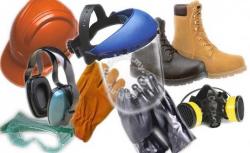Having adequate personal protective equipment on hand and available for employees to use is a critical part of your workplace safety and compliance program.
OSHA regulations and applicable federal laws make employers responsible for the following:
• A thorough and complete survey and assessment of workplace hazards.
• Identifying all PPE required and ensuring it is purchased in sufficient quantity.
• Training in proper PPE usage and wear.
• Enforcing rules requiring PPE usage.
• Inspecting and maintaining PPE and replacing it when it gets worn out or becomes unserviceable.
• Keeping records of safety incidents and updating your PPE program as circumstances change.
You should follow these eight tips for achieving PPE best practices and safety compliance:
1 Have a written PPE policy. Putting your policy in writing sets the standard, and equips those filling that role in the future to hit the ground running – while keeping you in compliance with OSHA regulations.
2 Check state and federal regulations. Check federal, state and local regulations specific to your industry. If you’re not sure how, call your professional or industry association for help, or speak with an experienced and qualified consultant.
3 Enforce wear. Employees should be wearing appropriate PPE for their job activities and hazards at all times. Hold all levels of management accountable, and be willing to enforce it. CEOs or other senior executives visiting the assembly line should don the same PPE they require of others in that work area. In fact, a CEO visit with the right PPE can go a long way to helping enforce the standard.
4 Cross-check your PPE against Material Safety Data Sheets. Hazardous materials and chemical data sheets will contain recommendations for personal protective equipment. Ensure that your MSDSs on hand accurately reflect the chemicals and other hazardous substances in the workplace, and make sure that you have all the equipment on hand as recommended on the sheets.
5 Enforce rules on contractors working on your worksites. While contractors are generally expected to provide their own PPE, it’s still your responsibility to enforce safety procedures on your own property or on worksites where you are the general contractor with overall responsibility. Employees, however, are fully your own responsibility in all cases.
6 Ensure you have the correct hard hats. Not all hard hats are created equal. There are three classes:
• Class A: Provides protection against up to 2,200 volts of electricity.
• Class B: Provides protection against up to 20,000 volts, plus substantial protection against penetration and falling objects.
• Class C: No protection against high voltage.
7 Pay attention to details. Don’t just be satisfied with having gloves that look protective, for example. Does the situation require non-slip gloves? Do they only protect workers against heat and burns, or are they also resistant to electrical current? If so, to what voltage? Is that adequate, given the hazards present in your workplace?
Bring the same level of critical inquiry to all your other PPE needs.
8 Keep inspection records. Someone should be responsible for inspecting and signing off on your PPE at regular intervals, verifying that the necessary equipment is present and serviceable, and that lost or damaged items are replaced.
Remember that your PPE program is just one level among a hierarchy of protective measures your company should be taking. In fact, it’s the last level of safety management. You should also be implementing safety measures at the engineering level first, followed by safe work practices and administrative controls.